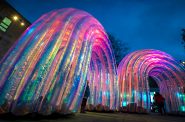The Aesthete
Whither beauty? wonders Kat. Thither and hither, San Francisco and MKE, Victorian and Modern.
In San Francisco recently, I saw The Cult of Beauty: The Victorian Avant-Garde, 1860-1900. The exhibition lives up to the great title. Particularly intriguing is the notion that beauty, and its associated principles, can inspire cult-like devotion. Desire for this quality can infiltrate all aspects of life, from art to clothing, even to furniture and wallpaper. It is quite a Romantic, idealistic notion.
The notion is, perhaps, escapist, but nonetheless seductive as a safety valve from the grind of daily life and contemporary stress. We are very practical people these days, not given much to reverie or revelry. Or maybe we are, seeing as how vampires have sunk their fangs into all manners of pop culture. But that’s another supernatural story.
One artist in the Cult of Beauty exhibition also has work in the Milwaukee Art Museum. Frederic Leighton’s At the Fountain captivates me each time I see it. There is an obvious beauty in it, to be sure, but such intrigue and balance. This figure is monumental, but filled with detail in the fragile folds of the gown and intimate garden setting. She is both graceful and solid, a woman of the modern 19th century decked out in the accoutrements of antiquity. Escapism, indeed!

Frederic Leighton, 1st Baron Leighton of Stretton (English, 1830–1896) At the Fountain, probably 1891–1892 Oil on canvas 50 1/4 x 37 1/2 in. (127.64 x 95.25 cm) Layton Art Collection, Gift of Friends of Layton Art Gallery L1895.1 Photo credit John R. Glembin
But beauty is not all languid airs and dreamy, far-off places and times. A Donald Judd sculpture appeals in quite another way. Such work as Judd’s Untitled, 1966/1968, works on me through its cool surety of perfect form and fabrication. The one on my mind comprises six steel and orange Plexiglass boxes, lined up on the wall in a segmented schema. They are so precise, clever, and almost snarky in the way everything is laid bare. You can see the top, the bottom, all sides, nothing is hidden, no surprises. But there are nuances, particularly in the right light, when gray shadows barely tinged with orange create triangular petals underneath. From the Untitled morphs into an expressionistic, three-dimensional Josef Albers painting.
After further consideration and justification, I can’t help but notice the predominant color of these two works is orange. Sometimes art tells you something you really hadn’t known about yourself. Socrates said “know thyself,” which I guess includes hidden color predilections.
What about you, dear reader? What works draw you in for the mysterious nourishment of beauty in all its strange indulgences and subjective pleasures?
Do share your comments below. And if you’re daring, in haiku form.
Beauty beholden
Eyes delight intrigue and grace
In the colors glow.
Art
-
Winning Artists Works on Display
 May 30th, 2024 by Annie Raab
May 30th, 2024 by Annie Raab
-
5 Huge Rainbow Arcs Coming To Downtown
 Apr 29th, 2024 by Jeramey Jannene
Apr 29th, 2024 by Jeramey Jannene
-
Exhibit Tells Story of Vietnam War Resistors in the Military
 Mar 29th, 2024 by Bill Christofferson
Mar 29th, 2024 by Bill Christofferson
























Perhaps see the Max Luscher Color Test for a very interesting analysis of the color orange.